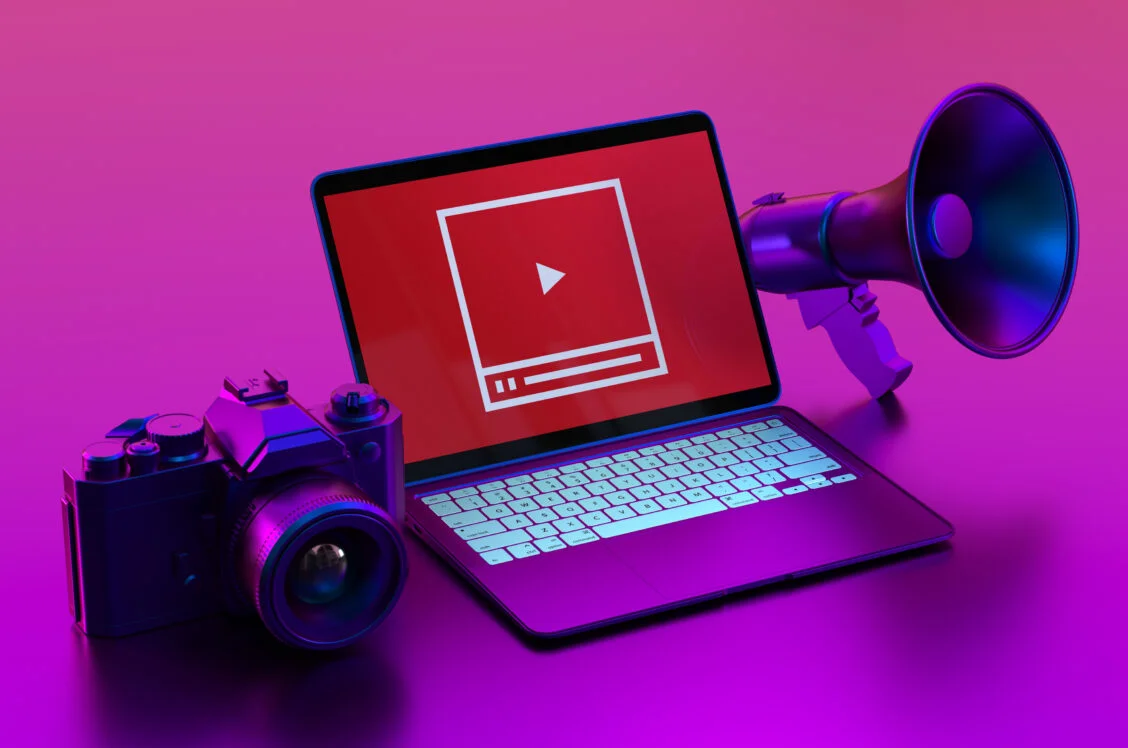
The YouTube creator economy guide for marketers
YouTube is the world’s largest streaming service by user base and market share. It even consistently ranks as the most-streamed service on U.S. televisions. The platform, where ordinary creators—including an abundance of video podcast creators—upload content that can be viewed for free, is supported by ads, which can run at the beginning, middle, or end of video content.
Today, there are nearly 2.8 billion global monthly active YouTube users, and that user base is expected to grow through 2028. Last year, the platform also became the primary source for users to tune in to podcasts, with 31% of listeners saying it is the platform they use most to access podcasts.
This means there are lots of opportunities for brands to leverage YouTube influencers in 2025. Today, 40% of marketers allocate a quarter of their budget to influencer campaigns every year. Eighty percent of those marketers say the channel is “highly effective.”
Given the wealth of content, variety of creators, and expansive user base on YouTube, there are opportunities for every brand to get in on the action. In this playbook, we’ll guide you through the process of leveraging these partnerships effectively. From selecting the right creators to avoiding the most common pitfalls, we cover the basics so you can skip the guesswork and get straight to the good stuff.
Understanding the Value of YouTube Influencers
YouTube influencers offer a unique advantage to brands looking to build deeper connections with their audiences. Unlike traditional ads or short-lived social media posts, YouTube’s long-form content allows creators to tell detailed stories, demonstrate products, and offer in-depth reviews. What’s more, YouTube influencers understand what will resonate with their audiences, so they can do all this in an authentic and meaningful way. YouTube’s long-form nature is powerful. A recent study found that 60% of YouTube users trusted recommendations more when a creator demonstrated knowledge about a product or service. As a result, 58% of consumers are at least somewhat likely to make the purchase.
The measurable impact of YouTube influencer marketing is hard to ignore. With an estimated market size of $32.55 billion across the influencer landscape, it’s no longer a question of whether this channel works—it’s about mastering its potential with a blend of data-driven insights and human creativity. In 2025, YouTube influencers provide brands with a credible voice and direct access to highly engaged niche communities, making them an essential component of any marketing strategy aimed at driving ROI.
How to Develop a YouTube Influencer Strategy
Given the incredible opportunities for brands through YouTube creator partnerships, the decision of whether to invest here is a no-brainer. It’s all about launching the campaign. Here’s a quick guide to get you started.
Identify the Right Influencers for Your Brand
According to 30% of marketers, finding the right influencers to partner with is one of the greatest challenges to working in this channel. While you could manually search YouTube or study your competitors’ sponsored content, that can be time consuming. The fastest path to connecting with the right YouTube influencers is to partner with an agency that has expertise and experience on the platform. Using their specialized industry knowledge, established partnerships, and proprietary data, including which categories and creators have delivered results for similar brands, it’s easy to connect with the right influencers from day one.
Alternatively, marketers can use hashtags, poll affinity groups, or keyword searches to discover influencers who are well matched to their product or service. From there, we recommend watching three to five pieces of content to ensure that the creator’s content consistently matches their brand values. From there, contact the creator’s management team to get the ball rolling.
Foster Successful Collaborations
To create the foundation for a successful collaboration with YouTube content creators, it’s important to first define the campaign’s objectives and clearly communicate the goals to the creator. Once aligned on goals, you can talk strategy. Provide the influencer with all relevant information about your product and service, as well as talking points that are necessary to deliver. Once you’ve thoroughly briefed your collaborator, let them take creative control. Chances are, the YouTube influencers you choose to work with know their audiences inside and out and can craft a message that will resonate.
In addition to establishing the right partnerships and letting creators work their magic, we find that ongoing partnerships can amplify trust, brand affinity, and results. By building a relationship with an influencer and their audience that extends beyond a transactional one-off, the marketing content often becomes more personalized and the collaboration more productive.
Track and Analyze Campaign Performance
Twenty-six percent of brands say that measuring ROI remains an obstacle. At ARM, we use a number of attribution methods to create a comprehensive picture of performance. These look different for different clients, depending on their goals and the campaign. Some of the measurement techniques we might use for a YouTube campaign include:
Vanity URLs
Vanity URLs help brands track the success of YouTube influencer campaigns by linking each influencer to a unique, branded URL. These links direct viewers to purpose-built landing pages, allowing us to measure clicks, conversions, and ROI for each creator and making it easy to see where value is created.
Promo & QR codes
Promo codes and QR codes are used in YouTube influencer campaigns to track individual performance by assigning each influencer a unique code. When viewers use the code at checkout, brands can directly attribute sales to that influencer, measure conversions, and assess ROI.
Engagement rates
Engagement rates measure how actively viewers interact with a YouTube influencer’s content through likes, comments, shares, and watch time. For brands, high engagement rates on content where their brand message is present indicate strong interest and trust, helping gauge how effectively an influencer’s content resonates and drives campaign impact beyond views.
Sentiment analysis
Sentiment analysis evaluates the tone of viewer comments and reactions on YouTube influencer content to understand how audiences feel about a brand or campaign. By analyzing whether feedback is positive, negative, or neutral, brands can gauge audience perception, identify potential issues, and refine messaging for future campaigns.
Purchase trends
Purchase trends track how consumer buying behavior changes during and after a YouTube creator campaign. By analyzing sales spikes, product preferences, and timing of purchases, brands can understand how influencer content drives conversions and identify which products or messages resonate most with their target audiences.
Avoid Common Pitfalls
Like any platform and marketing strategy, there may be hurdles on the path to success. We’ve outlined a few of the most common pitfalls in 2025.
- Don’t forget nano-influencers. Consumers care about authenticity and niche expertise. While broad reach can drive results for some campaigns, niche influencer collaborations drive big results, too, yet they are often overlooked by brands new to YouTube. In fact, 40% of consumers say that nano-influencers—those with 1,000 to d 10,000 followers, a step below the micro-influencer tier—are most likely to influence their purchase decisions.
- Don’t neglect ongoing education. Just like other platforms, YouTube is constantly evolving as new technologies emerge. AI-driven influencer discovery, tracking, and advanced analytics are becoming increasingly common. Stay up to date on how AI and other technologies are being applied to influencer marketing strategies to stay one step ahead of the competition.
- Don’t make YouTube a tactic; make it a strategy. When influencer campaigns are just a short-term tactic—popping up on a channel for a week or two and then disappearing forever—consumers are more likely to experience user fatigue, leaving brands unable to capitalize on the trust and authenticity creators have developed with their audiences. That’s why we recommend making YouTube influencer marketing a long-term strategy. When brands establish ongoing, long-term relationships with their influencer partners, not only is brand awareness improved, but the influencer’s audience also tends to exhibit stronger engagement. When influencers have long-term collaborations with brands, they may offer better rates and become true brand advocates, able to even more seamlessly integrate brand messages into their content.
YouTube Influencer Marketing Outlook: Trends to Watch
The YouTube creator marketplace is quickly evolving. Here are the trends that our industry experts are paying attention to in 2025.
Localized influencer strategies
There has been a broad movement toward localized strategies in influencer marketing. Partnering with local influencers can boost visibility and engage new audiences. More brands are seeking niche content creators in specific markets and community leaders in areas where they want to build their brand to drive ROI. Hyperlocal campaigns and creator communities can positively drive relevance within specific geographic areas.
Creators become consultants
Don’t fail to take advantage of the strategic insights of your influencer collaborators. In 2025, we’re witnessing an emerging trend where YouTube influencers are becoming consultants for their brand clients. Today, influencers are providing valuable insights about their audiences, niche trends, marketing tactics, and platform algorithms to their partners.
AI streamlines the market
Many brands are already integrating AI into social efforts, but the potential to apply it to influencer marketing is becoming more expansive. It can help streamline influencer discovery, campaign management, and performance analysis. AI is changing the game by making influencer marketing more data-driven than ever. Seek partnerships with agencies leveraging the latest industry tools to take full advantage of AI innovations in the channel.
Conclusion
As we look ahead, it’s clear that YouTube influencer marketing remains a critical strategy for any brand seeking meaningful engagement and measurable results. From long-form storytelling to deep audience trust, YouTube creators offer an unmatched opportunity to connect with consumers in authentic, high-impact ways. The platform’s evolution—driven by podcast growth, nano-influencer channels, and localized content—means there’s a fit for every brand, regardless of size, industry, or goals. By embracing long-term relationships, leveraging smart measurement tactics, and avoiding common missteps, marketers can unlock significant value.
If you’re ready to elevate your marketing efforts and tap into the full power of YouTube influencer marketing, ARM is here to help. Our industry experts bring the data, tools, and relationships needed to build effective, future-ready campaigns. Reach out to ARM today to start connecting with the right creators and driving real ROI on YouTube in 2025.


